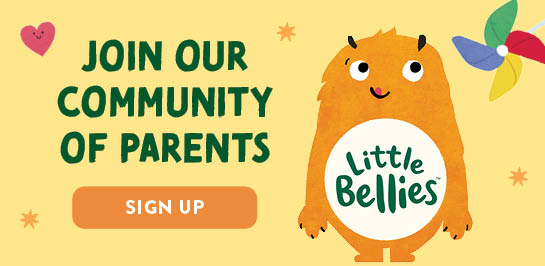Feeding Schedule for a 6 Months Baby
Reading time:
Reading time:

By: Mandy-Lee Adno, MSPAA, CPSP
When it comes to milestones in your baby’s life, starting solids may be one of the most exciting. Watching your baby’s reaction to something completely new and different in their mouth may be one of the most memorable experiences. With a large percentage of babies, the process of starting solids follows the normal pattern and using a step-by-step process they become established on solids. The introduction of solids is important for not only your baby’s nutritional health, but also for their oral skill development.
Starting solids is recommended between the age of 4 months and 6 months. Starting solids before 4 months is not recommended and unless advised by your doctor, solids should not be introduced later than 6 months. There is a range in the age recommendation as every baby is different. They all develop differently, with some showing signs of readiness earlier than others. When a baby is born, they have the iron stores from their mother, ensuring that they have enough iron in their body for the first few weeks of life. From around 6 months, their iron stores start depleting. To avoid iron deficiency, a baby needs to be eating foods containing iron so that their stores don’t deplete. Due to this, it is important for your baby to be established on solids and able to eat a range of foods before their iron stores deplete.
When it comes to oral skill development, babies need food to help develop tongue movements and chewing. There are critical periods for oral skill development and delaying the introduction of purees and finger foods can result in an oral skill delay or can result in fussiness with eating.
When deciding to start solids, rather than only focussing on age, there are also a few signs or developmental milestones that are important to look for. Is your baby:
For a closer look at starting solids, read our Introducing Solids Guide.
Before 10 months of age, breastmilk or formula should be your baby’s main source of nutrition. Due to this, start off giving your baby the breast or bottle and only once they have finished their feed, around 30minutes after their milk, offer solids. When starting, it is advisable to offer solids earlier in the day in case your baby has an allergic reaction to a food.
There are two approaches to starting your baby on food. First, spoon feeding and second, Baby-Led Weaning (BLW). Ideally, it is recommended to combine both approaches. Purees are about getting them ingesting or swallowing foods for nutrition, while BLW helps develop hand-to-mouth coordination and is the basis for developing chewing.
When first offering purees, ensure your baby is well positioned and supported in a high chair or bouncer. Make sure the spoon that you are using is small and has a flat bowl, matching the size of your baby’s mouth.
Ideally, the puree should be a very smooth runny consistency, making it easy for your baby to swallow. You can begin with pureed vegetables or fruits, ideally when starting to offer one type of food at a time. Seat yourself in front of your baby at their eye level and present the spoon to their mouth. Wait for them to open their mouth to accept the spoon, try not to force the spoon into their mouth. Once the spoon is in their mouth, gently push down on their tongue as this encourages them to close their lips around the spoon. As they close their lips, pull the spoon out of their mouth and their lips will clear the puree off the spoon. Initially, your baby may pull faces and spit the purees out. This does not indicate that they are not ready or that they don’t like the food, it is more about they discovering a new taste/texture and learning how to move their tongue differently to push the food back.
Continue feeding your baby until they show signs that they have had enough or are no longer opening their mouth. Some meals this may be 4tsp while others this may be after 1tsp. The important thing is to read your baby’s signs as to when they have had enough.
Baby-led weaning is a feeding approach that allows your baby to feed themselves. This approach focuses on finger foods rather than spoon feeding as a way of feeding. The most important factor with BLW is to ensure that your baby is developmentally ready to start with finger foods. BLW should NOT be introduced before 6 months. BLW should not solely be based on age but on developmental milestones. Ideally, if you are offering finger foods, your baby should have good head control and be able to sit up independently. Ensure your baby is seated in a highchair with support through their body, as well as having a support under their feet. Ensuring your baby is supported will enable them to utilise their oral skills when eating rather than focussing on using their tummy muscles to keep them upright to sit.
When starting, offer your baby fruits or vegetables that are of a soft squishable consistency. These foods should be able to be mashed with a fork with gentle pressure. Offering your baby pieces of food in longer finger shaped pieces will enable them to pick the food up and bring it to their mouth. At this age they have a raking action and will grab the food in the palm of their hand, making long fingers of food the ideal shape. They will not have developed the pincer grasp, so they will not be able to pick up small pieces of food. You can also offer quick-to-melt in the mouth Little Bellies Pick-up Sticks or Puffs. They also offer your baby a new texture and sensory experience as they have a crunchy texture compared to the fruits and vegetables which are soft and squishy.
The idea of BLW is for oral skill development. Having pieces of food in your baby’s mouth will help them learn how to chew. Ideally, they should be moving the pieces to the side of their mouth which is the start of the development of chewing.
With both approaches, initially your baby may pull a face, spit the food out and display signs that they do not like the food. The most important thing to remember is that these are all new experiences for your baby. If your baby reacts in this way, continue offering foods every day as at this age, your baby doesn’t have any definite likes or dislikes. Repeated exposure is key to avoiding fussiness and developing an acceptance of a wider range of foods.
More on BWL approach in our article Baby-Led-Weaning – Tips for New Parents.
When first starting to offer solids, start with one meal a day. Once they are established on this meal, after about 2 weeks, you can start offering a second meal. If they are tolerating the food and are not getting constipated, you can start offering 3 meals a day. It is important to remember that even if they are having 3 meals a day, their milk feeds (breast/bottle) are still the main source of their nutrition. Unless advised by a doctor, until 10 months, continue giving a milk feed first followed by a 30 min break and then a solid meal.
6:00 a.m.: Wake and breast or bottle
6:45 a.m.: Breakfast (smooth puree or soft squishable finger foods – as much as your baby will eat)
7:45 a.m. – 9:45 a.m.: Sleep
9:45 a.m.: Wake and breast or bottle
11:00 p.m.: Breast or bottle
11.30 a.m. Lunch (smooth puree or soft squishable finger foods – as much as your baby will eat)
12 p.m. – 1:30 p.m.: Sleep
1:30 p.m.: Breast or bottle
3:30 p.m. to 4:00 p.m.: Sleep
4:00 p.m.: Breast or bottle
4:30 p.m.: Dinner (smooth puree or soft squishable finger foods – as much as your baby will eat)
6 p.m.: Breast or bottle
6.30 p.m.: Bed
When it comes to allergies, ASCIA recommends the early introduction of all foods. Research has shown that delaying the introduction of foods can result in the development of allergies. Unless there is an immediate family allergy e.g. parent or sibling, you should be offering your baby all foods early. The only food that has an age limit is honey, which should not be offered under 12 months. This is not due to allergies, but the botulin spores that may be present.
When offering, give a new food early in the day. You can give your baby a new food every day and once they have had 2 foods and have not displayed any signs of intolerance or allergy, you can start combining foods.
The key to successful feeding is responsive feeding, which means listening to your baby and responding to their cues. Whether you are using spoon feeding or BLW, it is so important to read their signs. Try not focus on the volume or how many spoons of puree your baby has eaten, as this can result in over or under feeding your baby. While your baby is showing interest and opening their mouth for the spoon, continue to feed them. Once they start turning their head away, not opening for the spoon or attempting to bat the spoon away, stop feeding them.
Remember, variety in taste, colour and texture is key as this will lead to an increased acceptance of a wider range of foods and less fussiness as they get older.

Let’s Make It Official
Get the latest news on parenting tips, food play hacks, promotions and giveaways!
Subscribe Now